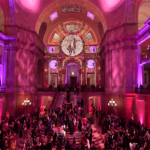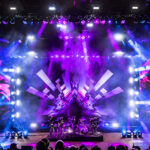Quince Imaging Dominates Pro Sports Arena Projection Mapping
It’s moments before the first Chicago Bulls NBA home game of the 2016-17 season begins, and the United Center Arena is packed with fans. Suddenly, the entire arena goes dark except for the court, which seems to glow with an inner light. The Bulls logo appears in the center, and the court floor comes to life as Bulls mascot Benny the Bull walks out to the center of the court, waving a Bulls flag in a grand circular motion.
As Benny moves, the court floor’s individual hardwood planks undulate, separate and melt away until the floor disappears entirely. Three-dimensional spirals and geometric patterns make the floor dance as circles of moving light begin a mad ballyhoo throughout the audience.
In another dazzling illusion, the floor appears to cave in, revealing a magma layer below — and a herd of bulls stampede out of the crevasse and seem to rush toward the audience. A last series of dazzling geometrics flash across the floor, then break away as the Chicago skyline appears, and the show turns into a photographic introduction of the team’s starting lineup, all synchronized with the hard-driving music pumping through the arena’s sound system.

What gave the season’s opening show its new burst of excitement and spectacular imagery? The United Center — home to the NHL’s Chicago Blackhawks as well as the NBA’s Chicago Bulls — has worked with Quince Imaging for the last several years, bringing in the veteran projection design company to boost the arena’s capabilities in the summer of 2016.
Quince engineers conducted a thorough assessment of the United Center rink and court and redesigned the system with enhanced image brightness and sharpness. The Quince engineering team — including systems engineers Eric Gazzillo and Liam O’Hanlon, and projection engineers Pablo D’Negri and Anthony Magdon — created a solution to simplify the lifetime serviceability of the projectors while simultaneously cutting maintenance costs.
Giving special attention to arena structural design, position of existing projectors and a survey of the lumen magnitude in each projector, they devised a strategy that included an upgrade of the existing eight projectors from 26,000 lumens to 30,000 lumens and the addition of four projectors to maximize brightness.

To streamline upkeep of the state-of-the-art projectors, the Quince team introduced a first-of-its-kind custom winch system. The system, engineered to minimize downtime in between events, seamlessly hoists and lowers all 12 projectors at the flip of a switch, saving thousands of dollars per year in labor fees.
With the upgraded projection system in place, the creative team went to work. Creative director CJ Davis, lead animators Zubair Parkar and Dylan Roscover, and 3D animator EJ Hassenfratz produced the dazzling array of images and effects that drive Bulls and Blackhawks fans wild at the beginning of each game.
Quince has spent the past two decades in the live entertainment business positioning itself as a visionary company and a frontrunner in putting new imaging technology to work. Among the other firsts under Quince’s belt is bringing video display for group audiences, use of displays for television backdrops and the achievement of truly seamless widescreen images. Most recently, Quince became the first company to bring projection image mapping to sports venues.
“In the last four to five years, the projection technology has advanced until it’s really bright and becoming more affordable,” said Scott Williams, chief operating and financial officer for Quince Imaging. “It really enables you to put pixels and brightness on things you couldn’t do before, and to be able to create an impactful high resolution image.”
Williams has logged 35 years in projection imaging and design, beginning his event career with Madonna’s coming out performance in New York City. Working for a government contractor early in his career, he gathered experience in big room shows and high-profile events like the opening and closing ceremonies for the 1996 Olympics. He has always kept pace with technology for bright, moving imagery — and when the next big thing arrived, he and Quince were ready to embrace it.
“With media server technology, we can manipulate and control multiple pixel spaces simultaneously,” he said. “This really enabled us to employ our expertise in projection image design into new markets and new areas, like sports arena courts, the sides of buildings, retail space applications and live events.”
Content is King
What sets Quince’s approach apart from other companies is its team of engineers and display designers. Its website proclaims in big, red letters: “We were not born of the AV business.”
Certainly equipment is important, noted Williams, and he depends on a tight circle of equipment suppliers including Barco and Christie projectors. The real differentiator, however, is the focus on content, not just special effects. “We weren’t the very first company to point a projector at a court, but we saw that people had tried it and it was done improperly,” he says. “It wasn’t bright enough, or someone just played a TV on a court or a rink.”
“Anyone can point a projector at a court,” noted CJ Davis, Quince Imaging creative director. “The recipe for the successful show is content. It has to work in the space that you have, it has to work for the viewing audience. Those considerations are paramount.”
With an approach that makes content the central priority, Quince helped the NBA and National Hockey League teams find ways to receive a return on their investment in a permanently installed projection system. The content can appear during breaks in the game, turning the arena into a powerful experiential marketing platform that entertains the captive audience.

“One of my favorite recent cases is with the Cleveland Cavaliers,” said Davis. “The Christmas Day show was sponsored by Beats By Dre. We put together a 60-second show, and we produced all of the court projection content, basing it around Beats’ ‘Be Heard’ campaign.”
Working with a company called PixMob, Quince had the arena staff distribute glowing bracelets to fans as they entered the arena. “We had communication with the bracelets, so on a signal they all lit up at once. We created this fully immersive experience where everyone in the arena was involved. I like how much synchronization we had.”
The audience goes wild for effects like these, Williams said. “People love it, and they record it on their cell phones, and tweet it and post it on Facebook. The life this has after the event is amazing.”
Quince has even created interactive video games on court surfaces, inviting audience members to come down and actually play. The media servers closely track the audience members’ movement as they chase video coins and drive them toward a goal, or bounce a glowing video puck back and forth in a game that resembles Pong, the patriarch of all video games.
This enthusiasm for pre-game and half-time projection shows at court and arena games has led the NFL and Major League Baseball to look closely at ways they can get into the act as well. Projecting onto bare ground and grass would have been lackluster at best just a few years ago, but today’s large venue DLP projectors have placed these shows within reach for outdoor sports.

When the Minnesota Vikings opened their new stadium in 2016, Quince — in collaboration with The Famous Group — coordinated all of the visuals to synchronize with a live orchestra on the field, even creating the illusion that the orchestra was on a raised stage. The middle of the field became a massive video projection of live singers paying tribute to Prince, who was a native son of Minneapolis. The audience lit lighters and cell phone flashlights, glowing in the otherwise complete darkness throughout the stands.
“The NFL usually does not let you turn the lights off, for fear that they will not go back on and they won’t be able to play,” said Williams. “Now, most of the sports teams have converted over to LED lighting. This means we can turn off the lights, so the projections can be brighter.”

Bigger, Brighter Events
In addition to sports arenas and stadiums, Quince has seen a marked increase in its corporate events business, including professional association conferences. “Big corporations wouldn’t think of doing an event without projection mapping,” said Williams.
For example, Quince, in partnership with event producer Kelly Press, built an opening show for the United Association of Plumbers and Pipefitters that featured multiple fly-through shots of a stylized water distribution system, complete with silhouettes of workers fitting pipes, welding and turning on and shutting off water flow.
For FotoWeek in Washington, DC, Quince lit the front of the National Geographic building so it appeared to passers-by that its tall marble columns snapped and wiggled like rubber bands. Meanwhile, lions strolled through a projected tundra, and flocks of birds took flight in a stunning optical illusion.
Quince has designed interactive displays for trade shows as well, including the booth design for Monterey Car Week 2016 event sponsor, Michelin, in which visitors could learn more about a specific vehicle by touching its image as it sped past them on a racetrack.
Can smaller companies and organizations afford this kind of high-impact projection work? Williams is quiet about what these productions cost, but he noted that the technology can be scaled to accommodate a wide variety of venues and customers.
“The big associated cost is the content,” he said. “The fact of the matter is that a great deal of the ones who were early adopters did not have a really solid plan to monetize the content. Now they have way more than monetized it.”
Monetizing involves finding sponsors who will pay premium rates to have their logos, products, or spokespeople featured in the show. “This more than pays for the client’s investment,” said Williams. “That’s great news for all of us in this industry, because that part of the argument is moot.”
So what’s on the horizon in projection mapping? Davis can only give hints: “Immersion is a word you hear a lot,” he said. “Especially in a world where virtual reality is becoming more popular, we see a world where you don’t need headsets. The highly personal experience is very powerful.“


